谷轮涡旋压缩机
谷轮压缩机的介绍
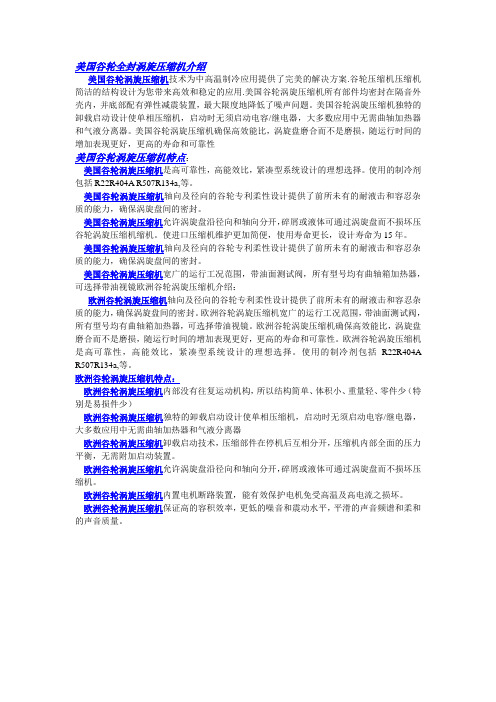
美国谷轮全封涡旋压缩机介绍美国谷轮涡旋压缩机技术为中高温制冷应用提供了完美的解决方案.谷轮压缩机压缩机简洁的结构设计为您带来高效和稳定的应用.美国谷轮涡旋压缩机所有部件均密封在隔音外壳内,并底部配有弹性减震装置,最大限度地降低了噪声问题。
美国谷轮涡旋压缩机独特的卸载启动设计使单相压缩机,启动时无须启动电容/继电器,大多数应用中无需曲轴加热器和气液分离器。
美国谷轮涡旋压缩机确保高效能比,涡旋盘磨合而不是磨损,随运行时间的增加表现更好,更高的寿命和可靠性美国谷轮涡旋压缩机特点:美国谷轮涡旋压缩机是高可靠性,高能效比,紧凑型系统设计的理想选择。
使用的制冷剂包括R22R404A R507R134a,等。
美国谷轮涡旋压缩机轴向及径向的谷轮专利柔性设计提供了前所未有的耐液击和容忍杂质的能力,确保涡旋盘间的密封。
美国谷轮涡旋压缩机允许涡旋盘沿径向和轴向分开,碎屑或液体可通过涡旋盘而不损坏压谷轮涡旋压缩机缩机。
使进口压缩机维护更加简便,使用寿命更长,设计寿命为15年。
美国谷轮涡旋压缩机轴向及径向的谷轮专利柔性设计提供了前所未有的耐液击和容忍杂质的能力,确保涡旋盘间的密封。
美国谷轮涡旋压缩机宽广的运行工况范围,带油面测试阀,所有型号均有曲轴箱加热器,可选择带油视镜欧洲谷轮涡旋压缩机介绍:欧洲谷轮涡旋压缩机轴向及径向的谷轮专利柔性设计提供了前所未有的耐液击和容忍杂质的能力,确保涡旋盘间的密封。
欧洲谷轮涡旋压缩机宽广的运行工况范围,带油面测试阀,所有型号均有曲轴箱加热器,可选择带油视镜。
欧洲谷轮涡旋压缩机确保高效能比,涡旋盘磨合而不是磨损,随运行时间的增加表现更好,更高的寿命和可靠性。
欧洲谷轮涡旋压缩机是高可靠性,高能效比,紧凑型系统设计的理想选择。
使用的制冷剂包括R22R404A R507R134a,等。
欧洲谷轮涡旋压缩机特点:欧洲谷轮涡旋压缩机内部没有往复运动机构,所以结构简单、体积小、重量轻、零件少(特别是易损件少)欧洲谷轮涡旋压缩机独特的卸载启动设计使单相压缩机,启动时无须启动电容/继电器,大多数应用中无需曲轴加热器和气液分离器欧洲谷轮涡旋压缩机卸载启动技术,压缩部件在停机后互相分开,压缩机内部全面的压力平衡,无需附加启动装置。
谷轮压缩机
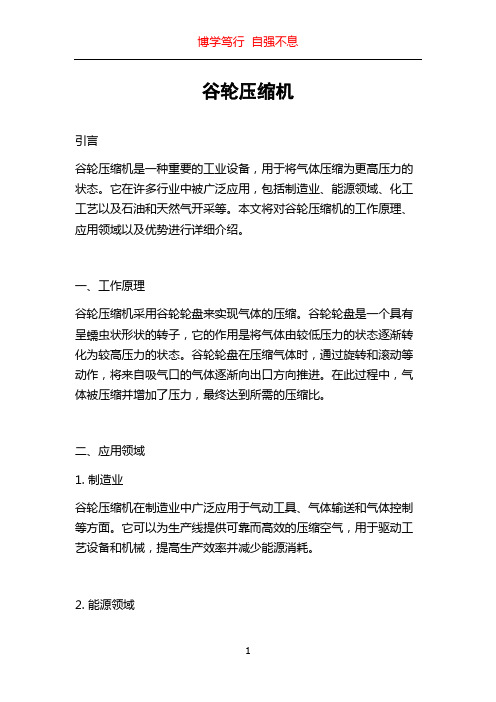
谷轮压缩机引言谷轮压缩机是一种重要的工业设备,用于将气体压缩为更高压力的状态。
它在许多行业中被广泛应用,包括制造业、能源领域、化工工艺以及石油和天然气开采等。
本文将对谷轮压缩机的工作原理、应用领域以及优势进行详细介绍。
一、工作原理谷轮压缩机采用谷轮轮盘来实现气体的压缩。
谷轮轮盘是一个具有呈蠕虫状形状的转子,它的作用是将气体由较低压力的状态逐渐转化为较高压力的状态。
谷轮轮盘在压缩气体时,通过旋转和滚动等动作,将来自吸气口的气体逐渐向出口方向推进。
在此过程中,气体被压缩并增加了压力,最终达到所需的压缩比。
二、应用领域1. 制造业谷轮压缩机在制造业中广泛应用于气动工具、气体输送和气体控制等方面。
它可以为生产线提供可靠而高效的压缩空气,用于驱动工艺设备和机械,提高生产效率并减少能源消耗。
2. 能源领域能源领域对于高效可靠的压缩机要求极高。
谷轮压缩机能够提供稳定的气体压力,使其在发电厂、核电站、石油和天然气工艺以及石油化工等领域得到广泛应用。
它可以用于驱动涡轮机、压缩站和天然气输送管道等设备。
3. 化工工艺化工工艺中需要将气体进行压缩和处理,以满足各种生产需求。
谷轮压缩机能够提供高效的压缩性能,并能适应不同的工作环境和气体成分。
因此,它被广泛应用于化工工艺中的气体压缩、净化、干燥和输送等过程。
4. 石油和天然气开采在石油和天然气开采的过程中,需要进行气体压缩和输送,以满足生产需求。
谷轮压缩机因其高效、可靠和适应性,成为石油和天然气行业的首选设备之一。
它可以用于压裂、注水、气体回收和输送等关键应用中。
三、优势1. 高效可靠谷轮压缩机采用谷轮轮盘来实现气体的压缩,具有高度的压缩效率和良好的稳定性。
它能够提供持续稳定的气体压力,并具有较低的能源消耗和维护成本。
2. 多功能性谷轮压缩机能够适应不同的气体成分和工作环境。
它可以根据不同的需求调整工作参数,以实现最佳的压缩效果。
3. 紧凑型设计谷轮压缩机通常采用紧凑型设计,占用空间小,并且安装和维护简便。
谷轮涡旋压缩机故障现象

谷轮涡旋压缩机故障现象谷轮涡旋压缩机主要故障主要有以下四种:①浮动密封圈损坏,高低压串气。
由涡旋压缩机的结构特点可知,为了在涡旋定子上部提供适当的气体压力,在涡旋定子上的适当的中间压缩处开了一个中间压力通道,以提供中间压力。
在中间压力腔上部设有浮动密封装置,因此涡旋顶部受排气压力与中间压力作用。
除了平衡涡旋内部压缩气体压力以外,还提供了顶端和底槽间的密封力,该密封力靠浮动密封圈来实现。
该密封圈由一种类似于橡胶或塑料的非金属材料制成。
故障现象一般表现为压缩机电机完好,并且能够通电运行,但机组的排气压力不升高,吸气压力也不降低,吸气与排气几乎没有压差,排气管不热,吸气管也不凉。
压缩机电流与额定值差别很大,事实上压缩机在空转。
②涡旋盘损坏。
涡旋盘损坏除有上述浮动密封圈损坏的特征外,还能听到压缩机内部明显的金属撞击声,这是涡旋盘被击碎后的金属碎片相互撞击或与压缩机壳体撞击的声音。
③电机烧毁。
当接通电源时,熔断器熔断或短路器跳断,压缩机无法启动。
④电机抱轴,轴承损坏。
压缩机电源接通时,听到机壳内电动机有嗡嗡的声音,但不运转,并且电流上升很快,几秒钟后,压缩机内部过载保护或外部热继电器保护动作,切断电源。
有时保护器来不及动作,很快达到堵转电流,可能直接导致电机烧毁。
2故障原因分析及防治措施2.1故障压缩机解剖后发现,密封圈发生了局部的融化或是断裂。
其原因是:由于制冷剂泄漏等原因,吸气压力降低(但是即使装了低压保护装置,也可能还没有达到保护设定值,而低压保护并没有切断),吸气过热度增大,致使排气温度迅速升高,这时,如果未装排气温度保护器,或是安装不当,会使系统存在严重的过热现象。
避免密封圈发生热损坏最有效的办法是正确安装排气温度保护器。
排气温度保护器的温度设定一般为125一130℃;排气温度保护器的感温包一般安装在压缩机排气管上,距离排气口不超过150 mm,感温包与排气管固定要牢固,并且需要严格保温;排气温度保护器的接线可以和压缩机的其他保护措施(如高压保护或低压保护)串联起来,共同形成对压缩机的保护。
艾默生涡旋变频压缩机和电控解决方案说明书

艾默生全系列涡旋变频压缩机和电控解决方案全面的安全保护和可靠性谷轮涡旋TM 压缩机传承了CoreSense TM 保护技术,将产品可靠性提升到新的高度。
通过将主动保护算法集成于电机控制变频器中,确保压缩机和变频器在各种异常工况运行的安全性。
主要有以下保护特征:• 电机和涡旋温度保护• 电机堵转检测• 相序保护和更正• 最大运行电流检测• 排气温度保护• 频繁启停循环保护该系列变频压缩机产品建立在高度的可靠性和经过验证的高性能基础之上,融合了艾默生25年的涡旋压缩机技术及全世界超过1亿台的运行经验。
为了帮助客户应对变频化的市场趋势,艾默生开发了4~25HP 变频压缩机和变频器的整体解决方案,全系列产品搭载多项创新技术,以业界顶级能效水平助力系统进入能效升级新时代。
结合谷轮引以为豪的喷气增焓技术,超低温环境下也能保证系统强效制热安全可靠。
同时推出的艾默生EVD 系列变频器专门针对永磁电机设计,完美匹配变频压缩机,一站式解决方案帮助客户快速响应市场需求。
变频压缩机型谱图浮动密封圈变容积比涡旋喷气增焓技术(可选)导油管高效集中卷六极永磁电机3.4mm厚壳设计柔性液体刹车容积式油泵谷轮涡旋™变频压缩机优势:• 优异的性能和噪音表现• 卓越的可靠性• 搭载高效艾默生永磁电机有效提升节能效果• 中国研发中心为亚太市场应用量身打造,苏州生产• 广泛适用于变频多联机、柜式空调、地暖等应用• 900-7200rpm 宽广频率范围,让系统设计更加游刃有余• 可变容积比技术(VVR)显著改善涡旋低转速下的能效运行范围喷气增焓(EVI)技术特点:• 专利技术的喷气增焓结构设计• EVI 回路气体进入压缩机后,通过特殊设计的通道注入涡旋, 注入涡旋的气体经过压缩,和吸气口吸入的气体一起排出,进入制冷循环• 喷气增焓带来制热能力的上升和排气温度的降低• 喷气增焓可取代系统辅助电加热艾默生谷轮涡旋™变频压缩机给家用制冷和制热系统带来了变革。
谷轮压缩机参数表.
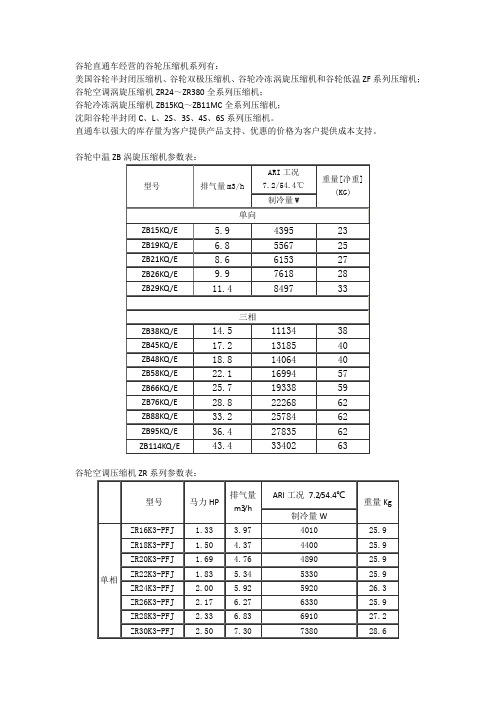
谷轮直通车经营的谷轮压缩机系列有:美国谷轮半封闭压缩机、谷轮双极压缩机、谷轮冷冻涡旋压缩机和谷轮低温ZF系列压缩机;谷轮空调涡旋压缩机ZR24~ZR380全系列压缩机;谷轮冷冻涡旋压缩机ZB15KQ~ZB11MC全系列压缩机;沈阳谷轮半封闭C、L、2S、3S、4S、6S系列压缩机。
直通车以强大的库存量为客户提供产品支持、优惠的价格为客户提供成本支持。
谷轮中温ZB涡旋压缩机参数表:谷轮空调压缩机ZR系列参数表:谷轮ZF系列低温压缩机参数表:型号HP 冷凝温度℃制冷量(W)10℃5℃0℃-5℃-10℃-15℃ZF06K4E 2 35 6950 5940 5040 4240 3550 2880 45 5960 5100 4330 3650 3050 2480 55 4910 4180 3550 3000 2520 2060ZF09K4E 3 35 9530 8130 6910 5820 4870 4100 45 8170 6970 5920 5000 4180 3550 55 6720 5730 4870 4120 3440 2900ZF11K4E 3.5 35 11700 10100 8550 7220 6050 5080 45 10200 8670 7370 6220 5210 4370 55 8400 7160 6050 5100 4260 3590ZF13K4E 4 35 12800 11300 9810 8420 7100 6030 45 11700 10100 8610 7250 6010 5120 55 9850 8320 6950 5780 4770 4070ZF15K4E 5 35 16800 14400 12200 10300 8650 7290 45 14500 12400 10500 88400 7390 6260 55 11900 10100 8570 7200 6030 5080ZF18K4E 6 35 17000 14400 12200 10200 8550 7250 45 14700 12500 10500 8840 7390 6240 55 12000 10200 8610 7250 6050 5120型号马力HP缸数排气量m3/h外形尺寸mm长宽高净重KG谷轮柔性涡旋压缩机在多方面显示出了它独特的优越性,高能效比,低噪音,高可靠性,低的系统设计成本和运行成本。
数码涡旋压缩机原理(简易)
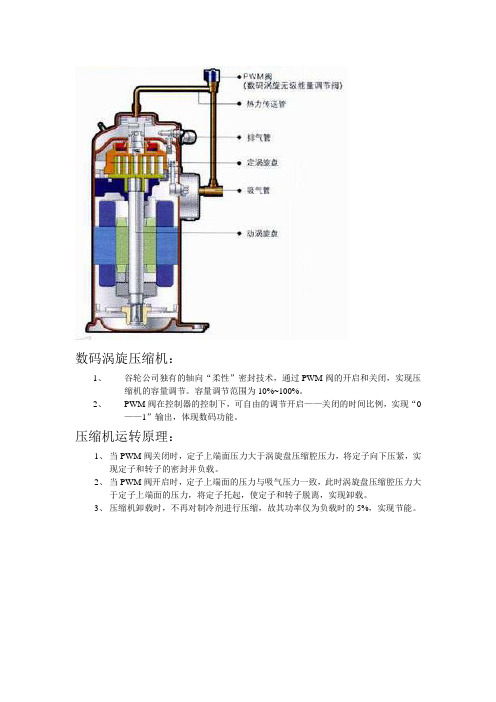
数码涡旋压缩机:
1、谷轮公司独有的轴向“柔性”密封技术,通过PWM阀的开启和关闭,实现压
缩机的容量调节。
容量调节范围为10%~100%。
2、PWM阀在控制器的控制下,可自由的调节开启——关闭的时间比例,实现“0
——1”输出,体现数码功能。
压缩机运转原理:
1、当PWM阀关闭时,定子上端面压力大于涡旋盘压缩腔压力,将定子向下压紧,实
现定子和转子的密封并负载。
2、当PWM阀开启时,定子上端面的压力与吸气压力一致,此时涡旋盘压缩腔压力大
于定子上端面的压力,将定子托起,使定子和转子脱离,实现卸载。
3、压缩机卸载时,不再对制冷剂进行压缩,故其功率仅为负载时的5%,实现节能。
变容量控制原理
通过压缩机周期性的负载和卸载来实现变容量冷媒控制。
以一次负载加一次卸载的时间为一个控制周期,一般一个周期时间为15~20秒。
通过负载在一个周期内所占时间的比例来实现不同的冷媒输出量,实现无级容量调节。
例如:总能力为10匹,控制周期为20秒。
若要输出5匹的能力,则负载时间占用周期时间的50%,即负载10秒,卸载为10秒即可。
若要输出2匹的能力,则负载时间占用周期时间的20%,即负载4秒,卸载为16秒即可,依次类推。
如下图列举输出能力分别为20%、50%、100%的控制原理图。
谷轮ZW系列(中间补气涡旋)压缩机应用指南

AE4-1381May 2011ZW21 to ZW61KAE and ZW30 to ZW61KSECopeland Scroll® Water Heating CompressorsTABLE OF CONTENTSSection Page Section PageIntroduction (2)ZW**KA Application (2)ZW**KS ApplicationVapour Injection - Theory of Operation (2)Heat Exchanger and Expansion Device Sizing (3)Flash Tank Application (3)Intermediate Pressure and Vapour Injection Superheat (3)Application ConsiderationsHigh Pressure Cut-Out (4)Low Pressure Cut-Out (4)Discharge Temperature Protection (4)Discharge Temperature Control (4)Discharge Mufflers (4)Oil Dilution and Compressor Cooling (4)Electrical Considerations (5)Brazing and Vapour Injection Line (5)Low Ambient Cut-Out (5)Internal Pressure Relief Valve (5)Internal Temperature Protection (5)Quiet Shutdown (5)Discharge Check Valve (5)Motor Protector (5)Accumulators (5)Screens (6)Crankcase Heat-Single Phase (6)Crankcase Heat-Three Phase (6)Pump Down Cycle (6)Minimum Run Time (6)Reversing Valves (6)Oil Type (7)System Noise & Vibration (7)Single Phase Starting Characteristics (7)PTC Start Components (7)Electrical Connections (7)Deep Vacuum Operation (7)Shell Temperature (7)Suction & Discharge Fittings (7)Three Phase Scroll Compressors (8)Brief Power Interruptions ..........................................8Assembly Line ProceduresInstalling the Compressor (8)Assembly Line Brazing Procedure (8)Pressure Testing (8)Assembly Line System Charging Procedure (8)High Potential (AC Hipot) Testing (9)Unbrazing System Components (9)Service ProceduresCopeland Scroll Functional Check (9)Compressor Replacement After Motor Burn (10)Start Up of a New or Replacement Compressor (10)FiguresBrief Product Overview (11)ZW21KAE Envelope (R-134a) (11)ZWKAE Envelope (R-407C, Dew Point) (12)ZWKA Envelope (R-22) (12)ZWKS Envelope (R-22) (13)ZWKSE Envelope (R-407C, Dew Point) (13)Heat Pump with Vapour Injection – EXV Control (14)Heat Exchanger Schematic (14)Heat Pump with Flash Tank (15)Possible Flash Tank Configuration (15)Oil Dilution Chart (16)Crankcase Heater (17)Compressor Electrical Connection (17)Scroll Tube Brazing (17)How a Scroll Works (18)IntroductionThe ZW**KA and ZW**KS Copeland Scroll®compressors are designed for use in vapour compression heat pump water heating applications. Typical model numbers include ZW30KA-PFS and ZW61KSE-TFP. This bulletin addresses the specifics of water heating in the early part and deals with the common characteristics and general application guidelines for Copeland Scroll compressors in the later sections. Operating principles of the scroll compressor are described in Figure 15 at the end of this bulletin.As the drive for energy efficiency intensifies, water heating by fossil-fueled boilers and electric elements is being displaced by vapour compression heat pumps. Emerson Climate Technologies has developed two lines of special water heater compressors to meet the requirements of this demanding application. ZW**KA compressors are designed for lighter duty applications where the ambient temperature does not fall below 0°C and where lower water temperatures can be accepted as the ambient temperature falls. ZW**KS compressors are equipped with a vapour injection cycle which allows reliable operation in cold climates with significantly enhanced heating capacity, higher efficiency, and minimal requirement to reduce water outlet temperatures. Figure 1gives a brief product overview.Water heating is characterized by long operating hours at both high load and high compression ratios. Demand for hot water is at its highest when ambients are low and when conventional heat pump capacity falls off. On the positive side, the system refrigerant charge is usually small, so the risk to the compressor from dilution and flooded starts will usually be lower than in split type air-to-air heat pumps.Water heaters must operate in a wide range of ambient temperatures, and many systems will require some method of defrost. Some systems such as Direct Heating, Top Down Heating or Single Pass Heating operate at a constant water outlet temperature with variable water flow. Others such as Recirculation Heating, Cyclic Heating or Multipass Heating use constant water flow with the water outlet and inlet temperatures both rising slowly as the storage tank heats up. Both system types need to cope with reheating a tank where the hot water has been partially used, and reheating to the setpoint temperature is required. More complex systems deliver water at relatively low temperatures for under-floor heating circuits and are switched over to sanitary water heating a few times per day to provide higher temperature water for sanitary use. In addition, some countries have specific water temperature requirements for legionella control.ZW**KA ApplicationThe application envelopes for ZW**KA compressors are shown in Figures 2 - 4.Appropriate system hardware and control logic must be employed to ensure that the compressor is always operating within the envelope. Small short-term excursions outside the envelope are acceptable at the time of defrost when the load on the compressor is low. Operation with suction superheat of 5 -10K is generally acceptable except at an evaporating tem-perature above 100C when a minimum superheat of 10K is required.ZW**KS ApplicationThe ZW**KS* vapour-injected scroll compressors differ from ZW**KA models in many important details:• Addition of vapour injection• Significantly different application envelopes• Some differences in locked rotor amps (LRA), maximum continuous current (MCC), andmaximum operating current (MOC) – seenameplatesThe application envelopes for ZW**KS compressors are shown in Figures 5 and 6.Vapour Injection – Theory of Operation Operation with vapour injection increases the capacity of the outdoor coil and in turn the capacity and efficiency of the system – especially in low ambient temperatures. A typical schematic is shown in Figure 7. A heat exchanger is added to the liquid line and is used to cool the liquid being delivered to the heating expansion device. Part of the liquid refrigerant flow is flashed through an expansion valve on the evaporator side of the heat exchanger at an intermediate pressure and used to subcool the main flow of liquid to the main expansion device. Vapour from the liquid evaporating at intermediate pressure is fed to the vapour injection port on the ZW**KS compressor. This refrigerant is injected into the mid-compression cycle of the scroll compressor and compressed to discharge pressure. Heating capacity is increased, because low temperature liquid with lower specific enthalpy supplied to the outdoor coil increases the amount of heat that can be absorbed from the ambient air. Increased heat absorbed from the ambient increases the system condensing temperature and in turn the compressor power input. The increase in power inputalso contributes to the improvement in the overall heating capacity.Vapour Injection can be turned on and off by the addition of an optional solenoid valve on the vapour injection line on systems using a thermostatic expansion valve. Alternatively, an electronic expansion valve can be used to turn vapour injection on and off and to control the vapour injection superheat. A capillary tube is not suitable for controlling vapour injection.The major advantage of the electronic expansion valve is that it can be used to optimise the performance of the system and at the same time control the discharge temperature by injecting “wet vapour” at extreme operating conditions.The configurations and schematics shown are for reference only and are not applicable to every system. Please consult with your Emerson Application Engineer.Heat Exchanger and Expansion Device Sizing Various heat exchanger designs have been used successfully as subcoolers. In general they should be sized so that the liquid outlet temperature is less than 5K above the saturated injection temperature at the customer low temperature rating point. At very high ambient temperatures, it will normally be beneficial to turn vapour injection off to limit the load on the compressor motor. Application Engineering Bulletin AE4-1327 and Emerson Climate Technologies Product Selection Software can be used to help size the subcooling heat exchanger and thermal expansion valves, but selection and proper operation must be checked during development testing. Plate type subcoolers must be installed vertically with the injection expansion device connected at the bottom through a straight tube at least 150mm long to ensure good liquid distribution. See the schematic in Figure 8. Flash Tank ApplicationA possible flash tank configuration is shown in Figure9. This particular configuration is arranged to have flow through the flash tank and expansion devices in heating, and it bypasses the tank in defrost mode. The flash tank system works by taking liquid from the condenser and metering it into a vessel through a high-to-medium pressure expansion device. Part of the liquid boils off and is directed to the compressor vapour injection port. This refrigerant is injected into the mid-compression cycle of the scroll compressor and compressed to discharge pressure. The remaining liquid is cooled, exits from the bottom of the tank at intermediate pressure, and flows to the medium-to-low pressure expansion device which feeds the outdoor coil. Low temperature liquid with lower specific enthalpy increases the capacity of the evaporator without increasing mass flow and system pressure drops.Recommended tank sizing for single compressor application in this size range is a minimum of 200 mm high by 75 mm in diameter with 3/8 in. (9.5mm) tubing connections, although it is possible to use a larger tank to combine the liquid/vapour separation and receiver functions in one vessel. A sight tube (liquid level gauge) should be added to the tank for observation of liquid levels during lab testing. See schematic diagram Figure 10 for clarification.It is important to maintain a visible liquid refrigerant level in the tank under all operating conditions. Ideally the liquid level should be maintained in the 1/3 to 2/3 full range.Under no circumstances should the level drop to empty or rise to a full tank. As the tank level rises, liquid droplets tend to be swept into the vapour line leading to “wet” vapour injection. Although this can be useful for cooling a hot compressor, the liquid quantity cannot be easily controlled. Compressor damage is possible if the tank overflows. If liquid injection is required for any reason, it can be arranged as shown in Figures 7 and 9.Since liquid leaves the tank in a saturated state, any pressure drop or temperature rise in the line to the medium-to-low pressure expansion device will lead to bubble formation. Design or selection of the medium-to-low pressure expansion device requires careful attention due to the possible presence of bubbles at the inlet and the low pressure difference available to drive the liquid into the evaporator. An electronic expansion valve is the preferred choice. Intermediate Pressure and Vapour Injection SuperheatPressure in the flash tank cannot be set and is a complex function of the compressor inlet condition and liquid condition at the inlet of the high-to-medium pressure expansion device. However, liquid level can be adjusted, which in turn will vary the amount of liquid subcooling in the condenser (water to refrigerant heat exchanger) and vary the injection pressure. Systems with low condenser subcooling will derive the biggest gains by the addition of vapour injection. Systems operating with high pressure ratios will show the largest gains when vapour injection is applied. Such systems will have higher vapour pressure and higher injectionmass flow. Intermediate pressures in flash tank and heat exchanger systems should be very similar unless the subcooling heat exchanger is undersized and there is a large temperature difference between the evaporator and the liquid sides. Vapour exiting a flash tank will be saturated and may pick up 1 - 2K superheat in the vapour line to the compressor. Vapour injection superheat cannot be adjusted on flash tank systems. Heat exchanger systems will be at their most efficient when the vapour injection superheat is maintained at approximately 5K.APPLICATION CONSIDERATIONSHigh Pressure Cut OutIf a high pressure control is used with these compressors, the recommended maximum cut out settings are listed in Figure 1. The high pressure control should have a manual reset feature for the highest level of system protection. It is not recommended to use the compressor to test the high pressure switch function during the assembly line test.Although R-407C runs with higher discharge pressure than R-22, a common setting can be used. The cutout settings for R-134a are much lower, and the switches must be selected or adjusted accordingly.Low Pressure Cut OutA low pressure cut out is an effective protection against loss of charge or partial blockage in the system. The cut out should not be set more than 3 - 5K equivalent suction pressure below the lowest operating point in the application envelope. Nuisance trips during defrost can be avoided by ignoring the switch until defrost is finished or by locating it in the line between the evaporator outlet and the reversing valve. This line will be at discharge pressure during defrost. Recommended settings are given in Figure 1. Discharge Temperature ProtectionAlthough ZW compressors have an internal bi-metal Therm-O-Disc®(TOD) on the muffler plate, external discharge temperature protection is recommended for a higher level of protection and to enable monitoring and control of vapour injection on ZW**KS* models. The protection system should shut down the compressor when the discharge line temperature reaches 125°C. In low ambient operation, the temperature difference between the scroll center and the discharge line is significantly increased, so protection at a lower discharge temperature, e.g. 120°C when the ambient is below 0°C, will enhance system safety. For the highest level of system protection, the discharge temperature control should have a manual reset feature. The discharge sensor needs to be well insulated to ensure that the line temperature is accurately read. The insulation material must not deteriorate over the expected life of the unit.Discharge Temperature ControlSome systems use an electronic expansion valve to control the vapour injection superheat and a thermistor to monitor the discharge temperature. This combination allows the system designer to inject a small quantity of liquid to keep the discharge temperature within safe limits and avoid an unnecessary trip. Liquid injection should begin at approximately 115°C and should be discontinued when the temperature falls to 105°C. Correct functioning of this system should be verified during system development. It is far preferable to use liquid injection into the vapour injection port to keep the compressor cool rather than inject liquid into the compressor suction which runs the risk of diluting the oil and washing the oil from the moving parts. If some operation mode requires liquid injection but without the added capacity associated with “wet” vapour injection, a liquid injection bypass circuit can be arranged as shown in Figures 7 and 9.Caution: Although the discharge and oil temperature are within acceptable limits, the suction and discharge pressures cannot be ignored and must also fall within the approved application envelope.Discharge MufflersDischarge mufflers are not normally required in water heaters since the refrigerant does not circulate within the occupied space.Oil Dilution and Compressor CoolingThe oil temperature diagram shown in Figure 11is commonly used to make a judgment about acceptable levels of floodback in heat pump operation. Systems operating with oil temperatures near the lower limit line are never at their most efficient. Low ambient heating capacity and efficiency will both be higher if floodback is eliminated and the system runs with 1 - 5K suction superheat. Discharge temperature can be controlled by vapour injection, “wet” vapour injection, or even liquid injection if necessary. In this situation, the oil temperature will rise well into the safe zone, and the compressor will not be at risk of failure from diluted oil. The oil circulation rate will also be reduced as crankcase foaming disappears. Special care needs to be taken at the end of defrost to ensure that the compressor oil is not unacceptably diluted. The system will resume heating very quickly and bearing loads willincrease accordingly, so proper lubrication must be ensured.Electrical ConsiderationsMotor configuration and protection are similar to those of standard Copeland Scroll compressors. In some cases, a larger motor is required in the ZW**KS* models to handle the load imposed by operating with vapour injection. Wiring and fuse sizes should be reviewed accordingly.Brazing the Vapour Injection LineThe vapour injection connection is made from copper coated steel, and the techniques used for brazing the suction and discharge fittings apply to this fitting also. Low Ambient Cut-OutA low ambient cut-out is not required to limit heat pump operation with ZW**KS compressors. Water heaters using ZW**KA compressors must not be allowed to run in low ambients since this configuration would run outside of the approved operating envelope causing overheating or excessive wear. A low ambient cut-out should be set at 0°C for ZW**KA modelsIn common with many Copeland Scroll compressors, ZW models include the features described below: Internal Pressure Relief (IPR) ValveAll ZW compressors contain an internal pressure relief valve that is located between the high side and the low side of the compressor. It is designed to open when the discharge-to-suction differential pressure exceeds 26 - 32 bar. When the valve opens, hot discharge gas is routed back into the area of the motor protector to cause a trip.Internal Temperature ProtectionThe Therm-O-Disc® or TOD is a temperature-sensitive snap disc device located on the muffler plate between the high and low pressure sides of the compressor. It is designed to open and route excessively hot discharge gas back to the motor protector. During a situation such as loss of charge, the compressor will be protected for some time while it trips the protector. However, as refrigerant leaks out, the mass flow and the amperage draw are reduced and the scrolls will start to overheat.A low pressure control is recommended for loss of charge protection in heat pumps for the highest level of system protection. A cut out setting no lower than 2.5 bar for ZW**KA* models and 0.5 bar for ZW**KS* models is recommended. The low pressure cut-out, if installed in the suction line to the compressor, can provide additional protection against an expansion device failed in the closed position, a closed liquid line or suction line service valve, or a blocked liquid line screen, filter, orifice, or TXV. All of these can starve the compressor for refrigerant and result in compressor failure. The low pressure cut-out should have a manual reset feature for the highest level of system protection. If a compressor is allowed to cycle after a fault is detected, there is a high probability that the compressor will be damaged and the system contaminated with debris from the failed compressor and decomposed oil.If current monitoring to the compressor is available, the system controller can take advantage of the compressor TOD and internal protector operation. The controller can lock out the compressor if current draw is not coincident with the contactor energizing, implying that the compressor has shut off on its internal protector. This will prevent unnecessary compressor cycling on a fault condition until corrective action can be taken.Quiet Shut downAll scrolls in this size range have a fast acting valve in the center of the fixed scroll which provides a very quiet shutdown solution. Pressure will equalize internally very rapidly and a time delay is not required for any of the ZW compressors to restart. Also refer to the section on “Brief Power Interruption”. Discharge Check ValveA low mass, disc-type check valve in the discharge fitting of the compressor prevents the high side, high pressure discharge gas from flowing rapidly back through the compressor. This check valve was not designed to be used with recycling pump down because it is not entirely leak-proof.Motor ProtectorConventional internal line break motor protection is provided. The protector opens the common connection of a single-phase motor and the center of the Y connection on three-phase motors. The three-phase protector provides primary single-phase protection. Both types of protectors react to current and motor winding temperature.AccumulatorsThe use of accumulators is very dependent on the application. The scroll’s inherent ability to handle liquid refrigerant during occasional operating flood back situations often makes the use of an accumulator unnecessary in many designs. If flood back is excessive, it can dilute the oil to such an extent thatbearings are inadequately lubricated, and wear will occur. In such a case, an accumulator must be used to reduce flood back to a safe level that the compressor can handle.In water heaters, floodback is likely to occur when the outdoor coil frosts. The defrost test must be done at an outdoor ambient temperature of around 0°C in a high humidity environment. Liquid floodback must be monitored during reversing valve operation, especially when coming out of defrost. Excessive floodback occurs when the sump temperature drops below the safe operation line shown in Figure 11 for more than 10 seconds.If an accumulator is required, the oil return orifice should be 1 - 1.5mm in diameter depending on compressor size and compressor flood back results. Final oil return hole size should be determined through testing. ScreensScreens with a mesh size finer than 30 x 30 (0.6mm openings) should not be used anywhere in the system with these compressors. Field experience has shown that finer mesh screens used to protect thermal expansion valves, capillary tubes, or accumulators can become temporarily or permanently plugged with normal system debris and block the flow of either oil or refrigerant to the compressor. Such blockage can result in compressor failure.Crankcase Heater - Single PhaseCrankcase heaters are not required on single phase compressors when the system charge is not over 120% of the limit shown in Figure 1. A crankcase heater is required for systems containing more than 120% of the compressor refrigerant charge limit listed in Figure 1. This includes long line length systems where the extra charge will increase the standard factory charge above the 120% limit.Experience has shown that compressors may fill with liquid refrigerant under certain circumstances and system configurations, notably after longer off cycles when the compressor has cooled. This may cause excessive start-up clearing noise, or the compressor may lock up and trip on the protector several times before starting. The addition of a crankcase heater will reduce customer noise and light dimming complaints since the compressor will no longer have to clear out liquid during startup. Figure 12lists the crankcase heaters recommended for the various models and voltages.Crankcase Heat – Three-PhaseA crankcase heater is required for three-phase compressors when the system charge exceeds the compressor charge limit listed in Figure 1and an accumulator cannot be piped to provide free liquid drainage during the off cycle.Pump Down CycleA pump down cycle for control of refrigerant migration is not recommended for scroll compressors of this size. If a pump down cycle is used, a separate external check valve must be added.The scroll discharge check valve is designed to stop extended reverse rotation and prevent high-pressure gas from leaking rapidly into the low side after shut off. The check valve will in some cases leak more than reciprocating compressor discharge reeds, normally used with pump down, causing the scroll compressor to cycle more frequently. Repeated short-cycling of this nature can result in a low oil situation and consequent damage to the compressor. The low-pressure control differential has to be reviewed since a relatively large volume of gas will re-expand from the high side of the compressor into the low side on shut down. Minimum Run TimeThere is no set answer to how often scroll compressors can be started and stopped in an hour, since it is highly dependent on system configuration. Other than the considerations in the section on Brief Power Interruptions, there is no minimum off time. This is because scroll compressors start unloaded, even if the system has unbalanced pressures. The most critical consideration is the minimum run time required to return oil to the compressor after startup.Since water heaters are generally of compact construction, oil return and short cycling issues are rare. Oil return should not be a problem unless the accumulator oil hole is blocked.Reversing ValvesSince Copeland Scroll compressors have very high volumetric efficiency, their displacements are lower than those of comparable capacity reciprocating compressors. As a result, Emerson recommends that the capacity rating on reversing valves be no more than 2 times the nominal capacity of the compressor with which it will be used in order to ensure proper operation of the reversing valve under all operating conditions.The reversing valve solenoid should be wired so that the valve does not reverse when the system isshut off by the operating thermostat in the heating or cooling mode. If the valve is allowed to reverse at system shutoff, suction and discharge pressures are reversed to the compressor. This results in pressures equalizing through the compressor which can cause the compressor to slowly rotate until the pressures equalize. This condition does not affect compressor durability but can cause unexpected sound after the compressor is turned off.Oil TypeThe ZW**K* compressors are originally charged with mineral oil. A standard 3GS oil may be used if the addition of oil in the field is required. See the compressor nameplate for original oil charge. A complete recharge should be ~100 ml less than the nameplate value.ZW**K*E are charged with POE oil. Copeland 3MAF or Ultra 22 CC should be used if additional oil is needed in the field. Mobil Arctic EAL22CC, Emkarate RL22, Emkarate 32CF and Emkarate 3MAF are acceptable alternatives. POE oil is highly hygroscopic, and the oil should not be exposed to the atmosphere except for the very short period required to make the brazing connections to the compressor.System Noise and VibrationCopeland Scroll compressors inherently have low sound and vibration characteristics, but the characteristics differ in some respects from those of reciprocating or rotary compressors. The scroll compressor makes both a rocking and a torsional motion, and enough flexibility must be provided to prevent vibration transmission into any lines attached to the unit. This is usually achieved by having tubing runs at least 30cm long parallel to the compressor crankshaft and close to the shell. ZW compressors are delivered with rubber grommets to reduce vibration transmission to the system baseplate.Single Phase Starting CharacteristicsStart assist devices are usually not required, even if a system utilizes non-bleed expansion valves. Due to the inherent design of the Copeland Scroll, the internal compression components always start unloaded even if system pressures are not balanced. In addition, since internal compressor pressures are always balanced at startup, low voltage starting characteristics are excellent for Copeland Scroll compressors. Starting current on any compressor may result in a significant “sag” in voltage where a poor power supply is encountered. The low starting voltage reduces the starting torque of the compressor and subsequently increases the start time. This could cause light dimming or a buzzing noise where wire is pulled through conduit. If required, a start capacitor and potential relay can be added to the electrical circuit. This will substantially reduce start time and consequently the magnitude and duration of both light dimming and conduit buzzing.PTC Start ComponentsFor less severe voltage drops or as a start boost, solid state Positive Temperature Coefficient devices rated from 10 to 25 ohms may be used to facilitate starting for any of these compressors.Electrical ConnectionThe orientation of the electrical connections on the Copeland Scroll compressors is shown in Figure 13 and is also shown on the wiring diagram on the top of the terminal box cover.Deep Vacuum OperationScrolls incorporate internal low vacuum protection and will stop pumping (unload) when the pressure ratio exceeds approximately 10:1. There is an audible increase in sound when the scrolls start unloading. This feature does not prevent overheating and destruction of the scrolls, but it does protect the power terminals from internal arcing.Copeland Scroll compressors(as with any refrigerant compressor) should never be used to evacuate a refrigeration or air conditioning system. The scroll compressor can be used to pump down refrigerant in a unit as long as the pressures remain within the operating envelope. Prolonged operation at low suction pressures will result in overheating of the scrolls and permanent damage to the scroll tips, drive bearings and internal seal. (See AE24-1105 for proper system evacuation procedures.)Shell TemperatureCertain types of system failures, such as condenser or evaporator blockage or loss of charge, may cause the top shell and discharge line to briefly but repeatedly reach temperatures above 175ºC as the compressor cycles on its internal protection devices. Care must be taken to ensure that wiring or other materials, which could be damaged by these temperatures, do not come in contact with these potentially hot areas. Suction and Discharge FittingsCopeland Scroll compressors have copper plated steel suction and discharge fittings. These fittings are far more rugged and less prone to leaks than。
谷轮压缩机参数表
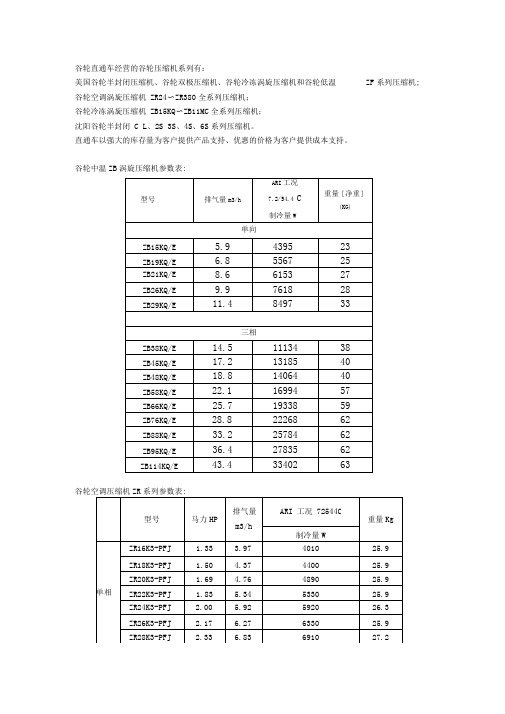
谷轮直通车经营的谷轮压缩机系列有:美国谷轮半封闭压缩机、谷轮双极压缩机、谷轮冷冻涡旋压缩机和谷轮低温ZF系列压缩机; 谷轮空调涡旋压缩机ZR24〜ZR380全系列压缩机;谷轮冷冻涡旋压缩机ZB15KQ〜ZB11MC全系列压缩机;沈阳谷轮半封闭C L、2S 3S、4S、6S系列压缩机。
直通车以强大的库存量为客户提供产品支持、优惠的价格为客户提供成本支持。
谷轮中温ZB涡旋压缩机参数表:谷轮空调压缩机ZR系列参数表:ZR32K3-PFJ 2.67 7.55 7760 28.1ZR34K3-PFJ 2.83 8.02 8200 29.5ZR36K3-PFJ 3.00 8.61 8790 29.5ZR40K3-PFJ 3.33 9.43 9670 29.9ZR42K3-PFJ 3.50 9.94 10100 29.9ZR47K3-PFJ 3.92 11.16 11500 30.4ZR22K3-TFD 1.83 5.34 5330 25.9ZR24K3-TFD 2.00 5.92 5920 25.9ZR26K3-TFD 2.17 6.27 6330 25.9ZR28K3-TFD 2.33 6.83 6910 26.3ZR30K3-TFD 2.50 7.30 7380 26.3ZR32K3-TFD 2.67 7.55 7760 26.3ZR34K3-TFD 2.83 8.02 8200 28.6ZR36K3-TFD 3.00 8.61 8790 27.2ZR40K3-TFD 3.33 9.43 9670 28.6ZR42K3-TFD 3.50 9.94 10100 28.6ZR45KC-TFD 3.75 10.73 11000 28.6ZR46KC-TFD 3.83 10.95 11100 34.9 三相ZR47KC-TFD 3.92 11.16 11500 28.6ZR49KC-TFD 4.08 11.45 11700 35.4ZR54KC-TFD 4.50 12.73 12900 35.4ZR57KC-TFD 4.75 13.42 13700 35.4ZR61KC-TFD 5.08 14.34 14600 35.8ZR68KC-TFD 5.75 16.18 16400 38.1ZR72KC-TFD 6.00 17.05 17400 38.1ZR81KC-TFD 6.75 19.20 19690 40.9ZR84KC-TFD 7.00 19.75 20330 56.7ZR94KC-TFD 8.00 22.14 22940 58.0 ZR108KC-TFD 9.00 25.15 26250 72.6 ZR125KC-TFD 10.00 28.77 30470 78.0型号马力HP缸数排气量m3/h外形尺寸净重mm长宽高KG型号HP 冷凝温度C制冷量(W)10C 5C 0C -5C -10C -15CZF06K4E 2 35 6950 5940 5040 4240 3550 2880 45 5960 5100 4330 3650 3050 2480 55 4910 4180 3550 3000 2520 20604100ZF09K4E 3 35 9530 8130 6910 5820 487045 8170 6970 5920 5000 4180 3550 55 6720 5730 4870 4120 3440 2900ZF11K4E 3.5 35 1170010200840010100 8550 7220 6050 5080 45 8670 7370 6220 5210 4370 55 7160 6050 5100 4260 35907F13K4E 4 35 12800 11300 9810 8420 7100 6030 45 11700 10100 8610 7250 6010 5120 55 9850 8320 6950 5780 4770 4070ZF15K4E 5 35 16800 14400 12200 10300 8650 7290 45 14500 12400 10500 1 88400 7390 6260 55 11900 10100 8570 7200 6030 5080ZF18K4E 6 35 17000 14400 12200 10200 8550 7250 45 14700 12500 10500 8840 7390 6240 55 12000 10200 8610 7250 6050 5120谷轮半封闭压缩机C系列参数表:■I“ xSu._1*4 .com618-9884谷轮压缩机卓越品质事鞠信赖谷轮柔性涡旋压缩机在多方面显示出了它独特的优越性,高能效比,低噪音,高可靠性,低的系统设计成本和运行成本。
美国谷轮公司是著名的艾默生电气的旗下公司
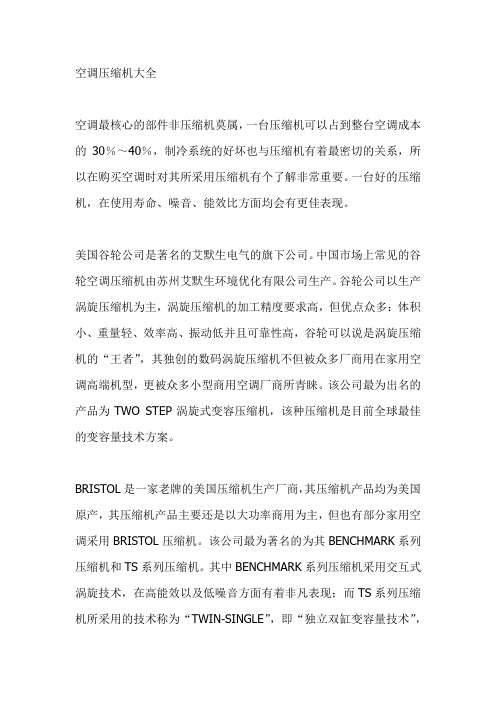
空调压缩机大全空调最核心的部件非压缩机莫属,一台压缩机可以占到整台空调成本的30%~40%,制冷系统的好坏也与压缩机有着最密切的关系,所以在购买空调时对其所采用压缩机有个了解非常重要。
一台好的压缩机,在使用寿命、噪音、能效比方面均会有更佳表现。
美国谷轮公司是著名的艾默生电气的旗下公司。
中国市场上常见的谷轮空调压缩机由苏州艾默生环境优化有限公司生产。
谷轮公司以生产涡旋压缩机为主,涡旋压缩机的加工精度要求高,但优点众多:体积小、重量轻、效率高、振动低并且可靠性高,谷轮可以说是涡旋压缩机的“王者”,其独创的数码涡旋压缩机不但被众多厂商用在家用空调高端机型,更被众多小型商用空调厂商所青睐。
该公司最为出名的产品为TWO STEP涡旋式变容压缩机,该种压缩机是目前全球最佳的变容量技术方案。
BRISTOL是一家老牌的美国压缩机生产厂商,其压缩机产品均为美国原产,其压缩机产品主要还是以大功率商用为主,但也有部分家用空调采用BRISTOL压缩机。
该公司最为著名的为其BENCHMARK系列压缩机和TS系列压缩机。
其中BENCHMARK系列压缩机采用交互式涡旋技术,在高能效以及低噪音方面有着非凡表现;而TS系列压缩机所采用的技术称为“TWIN-SINGLE”,即“独立双缸变容量技术”,这是除谷轮“TWO STEP”技术以外全球仅有的第二种变容量技术方案。
日本大金无论是在商用制冷还是家用制冷领域,都以可靠的品质和先进的技术赢得了崇高声誉。
大金压缩机以低噪和高效技术见长。
目前中国市场上的大金压缩机均为西安大金庆安压缩机有限公司生产,目前大金庆安公司共有四个系列的产品:G系列高效能涡旋式压缩机、D系列高能效涡旋式压缩机、B系列高能效涡旋压缩机、变频系列高能效涡旋压缩机。
其中D系列高能效涡旋式压缩机为世界上首次采用非对称涡旋技术的压缩机,该技术显著的提高了能效比。
西安庆安制冷设备股份有限公司的成员包括庆安集团及江苏春兰制冷股份有限等。
谷轮压缩机ZF系列

35 11700 10300 8930 7580 6340 5480 4520 3700 2980 2390 1890 2400 2260
ZF13K4 4
45 11300 9740 8270 6930 5750 5020 4140 3380 2730 2180 1740 2810 2650
55 10400 8800 7410 6220 5230 4490 3700 3020 2440 1950 1550 3430 3090
35
8820 7500 6320 5290 4410 3760 3150 2580 2080 1680 1320 1770 1710
ZF09K4 3
45
8090 6850 5780 4850 4030 3490 2880 2350 1910 1530 1220 2060 2000
55
7290 6170 5210 4360 3610 3130 2600 2140 1740 1410 1110 2420 2320
1/3。 2. 100%容积效率,高环境温度下冷量损失小。 3. 独特设计大大提高了低温应用时的制冷量。
ZF 系列谷轮压缩机 参数说明:
型号 HP 冷凝温度℃ 10℃ 5℃
制冷量(W)
输入功率 (W)
-10 -35 0℃ -5℃ -10℃ -15℃ -20℃ -25℃ -30℃ -35℃ -40℃
℃℃
55 15500 13100 11000 9220 7640 6550 5400 4390 3550 2840 2230 5210
本文源自:谷轮 114
35
6130 5290 4540 3840 3230 2690 2210 1790 1450 1160 900 1360 1350
谷轮涡旋压缩机_ZB_ZF
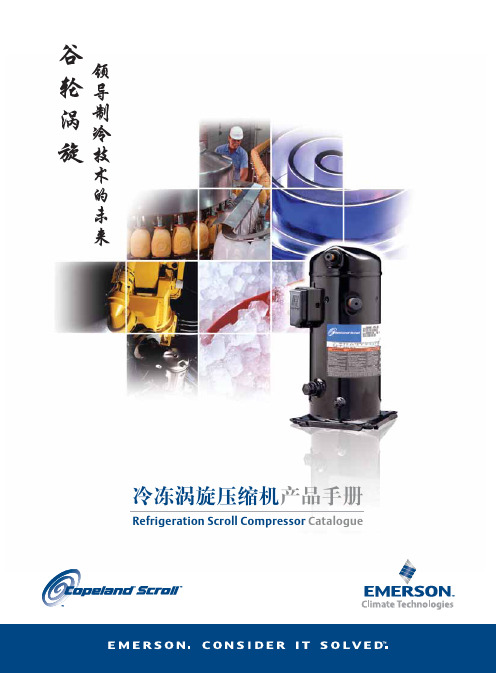
29000 25500
7790 9630
-5
17700 16100 14150 3920 4880 6100 20100 18400 16500 4360 5400 6750 23800 21700 19500 5100 6350 8000 27400 24900 22000 5750 7200 9050 29300 26500 22400 6590 8180 10100 35400 31700 27000 7920 9710 12050
2050 2550
8150 7300 6250 2490 3100 3880 10350 9400 8200 3160 3880 4810 11485 10390 9134 3246 4080 5116
* 最低蒸发温度保持-12℃
* 测试条件:回气温度20℃,过冷度0℃
*
最大吸气过热度为11K
-10
排气
动涡旋
径向柔性
轴 吸气
向 柔 性
高能效比 涡旋盘磨合而不是磨损 *随运行时间的增加表现更好 *容积效率高
更低的噪音和振动水平
平滑的声音频谱和柔和的声音质量
*压缩腔永远是对称分布 *很低的不平衡应力
*高精度的制造工艺
*无需振动吸收装置
卸载启动技术 压缩部件在停机后互相分开压缩机内部全面的压力平 衡,无需附加启动装置。
-5
4800 4350 3750 1090 1420 1840 5300 4850 4350 1250 1590 2000 6800 6200 5500 1620 2010 2500 7450 6800 6050 1750 2210 2780 9140 8290 7370 2070 2570 3190 11000 9950 8800 2540 3150 3900 13550 12400 11100 3170 3870 4780 15042 13700 12194 3312 4141 51822ຫໍສະໝຸດ 510HP
涡旋压缩机介绍

涡旋压缩机介绍EMERSON Climate 旗下谷轮公司是全球最大的制冷压缩机生产企业,目前在全球有23个工厂,6500名员工,2000年销售额近18亿美元,生产压缩机型号逾一万个,已累计生产2300万台涡旋压缩机,全封闭往复式压缩机总产量超过3000万台,产品广泛应用于全球的家用、商用空调系统以及商用冷冻设备上。
其中,涡旋压缩机工厂有9个,年产涡旋压缩机逾600万台。
谷轮公司创办于1921年。
从半封闭压缩机到全封闭压缩机,再到涡旋式压缩机,谷轮在全球压缩机发展史上始终是技术的领导者。
尤其值得一提的是,80年代中期,谷轮公司成功地研制出可批量生产的大功率涡旋压缩机,并随后创造性地提出"柔性"专利设计,使压缩机永远保持最佳磨合状态。
柔性涡旋压缩机的高效率和高可靠性使谷轮在全球压缩机市场的份额迅速增长。
从1993年到1998年,谷轮的柔性涡旋式压缩机的平均每年销量率超过26%。
此外,谷轮公司在环保产品方面也走在全球同行前列,目前具有最为齐全的环保制冷剂压缩机产品系列。
中央空调是一个完整而复杂的系统,但其最核心的技术--压缩机生产技术都掌控在日、美企业之手。
国内巨头无一例外地选择与洋巨头合作进军商用空调市场。
在进入商用空调领域的初期,国内家用空调企业分别选择大金、东芝等日本企业(掌握变频中央空调技术)和Copeland谷轮公司为代表的企业(掌控变容量技术)合作,美日两大技术阵营基本上势均力敌。
但近年来,因节能的技术优势,美国谷轮公司采用的变容量技术备受国内空调企业青睐。
国内空调巨头的合作重心转向了美国谷轮公司,如格力、美的、新科等,现在都大量购买谷轮公司生产的商用空调压缩机。
80多年来,美国谷轮公司一直是全球压缩机制造行业的领头羊,其在中国的业务也开展得相当顺利。
在2003 11日举行的《第十四届中国制冷展》上,谷轮公司连同艾默生环境优化技术旗下的艾可控制器(Alco Controls)及Therm-O-Disc,展出了最新产品,吸引了众多的参观者。
谷轮压缩机的型号解析
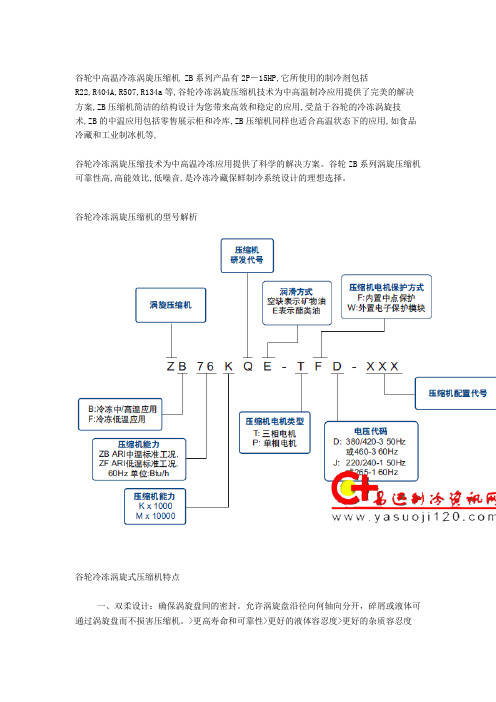
谷轮中高温冷冻涡旋压缩机 ZB系列产品有2P-15HP,它所使用的制冷剂包括
R22,R404A,R507,R134a等,谷轮冷冻涡旋压缩机技术为中高温制冷应用提供了完美的解决方案,ZB压缩机简洁的结构设计为您带来高效和稳定的应用,受益于谷轮的冷冻涡旋技
术,ZB的中温应用包括零售展示柜和冷库,ZB压缩机同样也适合高温状态下的应用,如食品冷藏和工业制冰机等,
谷轮冷冻涡旋压缩技术为中高温冷冻应用提供了科学的解决方案。
谷轮ZB系列涡旋压缩机可靠性高,高能效比,低噪音,是冷冻冷藏保鲜制冷系统设计的理想选择。
谷轮冷冻涡旋压缩机的型号解析
谷轮冷冻涡旋式压缩机特点
一、双柔设计:确保涡旋盘间的密封。
允许涡旋盘沿径向何轴向分开,碎屑或液体可通过涡旋盘而不损害压缩机。
>更高寿命和可靠性>更好的液体容忍度>更好的杂质容忍度
二、确保高效比涡旋盘磨合而不磨损。
>随运行时间的增加表现更好>保证高效的容积效率
三、更低的噪音和震动水平平滑的声音频谱和柔和的声音质量>压缩腔永远对称分布>很低的不平衡应力>高精度的制造工艺>无需震动吸收装置
四、卸载启动技术压缩部件在停机后互相分开压缩机内部全面的压力平衡,无需附加启动装置。
五、高效的“特氟龙”轴承>上部的主轴承和驱动轴承>太空时代材料(1)多孔渗透型青铜(2)聚四氟乙烯PTF涂层>在没有完全润滑的情况下延长运行时间>非常小的摩擦系数
易迅制冷主要经营谷轮压缩机、布里斯托压缩机、泰康压缩机、美优乐压缩机、百福马压缩机、大金压缩机、空调压缩机、制冷压缩机等世界知名品牌压缩机。
谷轮压缩机参数表
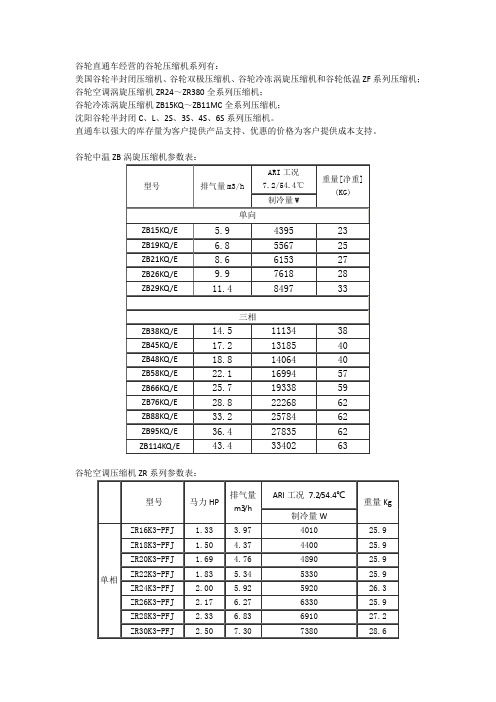
谷轮直通车经营的谷轮压缩机系列有:
美国谷轮半封闭压缩机、谷轮双极压缩机、谷轮冷冻涡旋压缩机和谷轮低温ZF系列压缩机;谷轮空调涡旋压缩机ZR24~ZR380全系列压缩机;
谷轮冷冻涡旋压缩机ZB15KQ~ZB11MC全系列压缩机;
沈阳谷轮半封闭C、L、2S、3S、4S、6S系列压缩机。
直通车以强大的库存量为客户提供产品支持、优惠的价格为客户提供成本支持。
谷轮中温ZB涡旋压缩机参数表:
谷轮空调压缩机ZR系列参数表:
谷轮ZF系列低温压缩机参数表:
谷轮半封闭压缩机C系列参数表:
谷轮柔性涡旋压缩机在多方面显示出了它独特的优越性,高能效比,低噪音,高可靠性,低的系统设计成本和运行成本。
谷轮的革命性技术已为世界各地的制造商,分销商和最终用户所采用。
到今天为止,谷轮有超过四千万台柔性涡旋压缩机服务于人类日常生活和科学研究等各个领域。
谷轮公司在开发空调柔性涡旋压缩机的同时,也在全力研发冷冻涡旋压缩机;涡旋在空调行业的成功应用,预示着冷冻的未来属于涡旋。
谷轮涡旋压缩机高温保护的原因
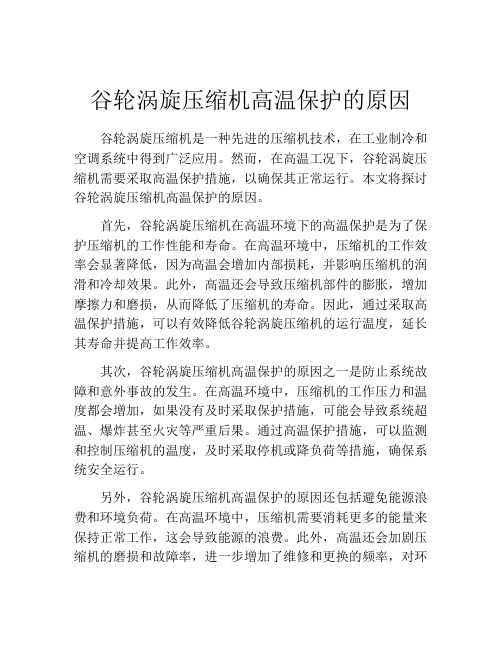
谷轮涡旋压缩机高温保护的原因谷轮涡旋压缩机是一种先进的压缩机技术,在工业制冷和空调系统中得到广泛应用。
然而,在高温工况下,谷轮涡旋压缩机需要采取高温保护措施,以确保其正常运行。
本文将探讨谷轮涡旋压缩机高温保护的原因。
首先,谷轮涡旋压缩机在高温环境下的高温保护是为了保护压缩机的工作性能和寿命。
在高温环境中,压缩机的工作效率会显著降低,因为高温会增加内部损耗,并影响压缩机的润滑和冷却效果。
此外,高温还会导致压缩机部件的膨胀,增加摩擦力和磨损,从而降低了压缩机的寿命。
因此,通过采取高温保护措施,可以有效降低谷轮涡旋压缩机的运行温度,延长其寿命并提高工作效率。
其次,谷轮涡旋压缩机高温保护的原因之一是防止系统故障和意外事故的发生。
在高温环境中,压缩机的工作压力和温度都会增加,如果没有及时采取保护措施,可能会导致系统超温、爆炸甚至火灾等严重后果。
通过高温保护措施,可以监测和控制压缩机的温度,及时采取停机或降负荷等措施,确保系统安全运行。
另外,谷轮涡旋压缩机高温保护的原因还包括避免能源浪费和环境负荷。
在高温环境中,压缩机需要消耗更多的能量来保持正常工作,这会导致能源的浪费。
此外,高温还会加剧压缩机的磨损和故障率,进一步增加了维修和更换的频率,对环境造成不必要的负荷。
通过高温保护措施,可以优化压缩机的工作温度,节约能源和减少环境负荷。
最后,谷轮涡旋压缩机高温保护的原因还与产品质量和稳定性有关。
在高温环境中,压缩机的工作状态非常不稳定,会导致压缩机的振动增大,噪音增加,并对产品的工作性能产生不利影响。
通过高温保护措施,可以有效控制谷轮涡旋压缩机的工作温度,提高产品的稳定性和可靠性,保证产品的质量。
综上所述,谷轮涡旋压缩机在高温工况下采取高温保护措施是非常必要的。
高温保护可以保护压缩机的工作性能和寿命,防止系统故障和意外事故的发生,避免能源浪费和环境负荷,并提高产品质量和稳定性。
因此,在实际应用中,我们应该重视谷轮涡旋压缩机的高温保护工作,确保系统的正常运行和安全性。
涡旋压缩机充油和无油涡旋压缩机

如果他们说“活塞式压缩机”——寻找活塞,你一定会找到的。
如果“螺杆式压缩机”——它意味着它有一个螺杆,而且很可能不止一个。
好吧,说到涡旋压缩机,很明显它们最重要的细节是一个涡旋,或者更确切地说,两个涡旋。
BITECH中的充油涡旋压缩机FINI大多数人无需进一步解释就明白了。
首先想到的是热电器的发热元件的炽热螺旋或儿童玩具和成人手表的螺旋形发条。
尽管在自然界中有更大螺旋的例子。
银河系是一个直径10万光年的棒旋星系,离它的外围更近的是太阳系和地球。
银河系不是唯一的螺旋星系。
它的卫星——大麦哲伦星云和小麦哲伦星云,以及仙女座星系、三角座星系等也是如此。
螺旋线是围绕一个点的曲线,取决于它是扭曲还是展开,接近还是远离该点。
涡旋压缩机的工作主体通常以阿基米德或渐开线螺旋的形式制成。
其他选项也是可能的,例如由圆弧形成的曲线。
阿基米德螺线可以比作一个点沿一条从中心O开始的射线均匀移动而留下的痕迹,该射线本身围绕它均匀旋转。
圆的渐开线,相对于经典的代数螺线,即阿基米德螺线,属于所谓的。
赝螺旋或螺旋曲线。
它可以表示为从位于直螺纹末端的点的轨迹,从圆柱形线圈盘绕或缠绕在它周围;在这种情况下,螺纹总是与圆相切——线圈圆柱的横截面。
甚至在直观的层面上也结合了螺杆和涡旋压缩机。
而不是偶然的。
他们的“血缘关系”甚至表现在词汇上。
的确,根据大百科辞典,螺旋线是“空间螺旋曲线”。
螺钉不过是“螺旋螺纹杆”。
螺杆式和涡旋式压缩机不仅通过词汇结合在一起,而且通过传记模式结合在一起。
包含这些机器操作原理的发明出现的时间远远早于它们不仅能够在工业规模上实施,甚至能够制造实验样品。
正如他们所说,两者都是开放的,“在笔尖”。
这些发现比他们的时代早了几十年,或者更确切地说,比当时现有的金属加工水平早了很多。
能够生产具有涡旋压缩机工作元件所需精度的零件的机床直到最近才出现。
开发涡旋压缩机装置的想法出现在19世纪。
他们在20世纪初的1905年找到了和谐的设计。
谷轮涡旋压缩机高温保护

谷轮涡旋压缩机高温保护谷轮涡旋压缩机高温保护引言:随着工业技术的不断发展和进步,涡旋压缩机在许多领域中扮演着重要的角色。
谷轮涡旋压缩机作为一种高效能,无油润滑、无脉动、无振动、噪音低、运行可靠等特点的压缩机,被广泛应用于制冷、空调、石油、化工等领域。
然而,由于工作环境和操作条件的限制,谷轮涡旋压缩机在运行过程中很容易发生高温问题,而高温问题对设备的寿命和性能造成了严重影响。
因此,针对谷轮涡旋压缩机高温问题的研究成为了一个热点话题。
什么是谷轮涡旋压缩机高温保护?谷轮涡旋压缩机高温保护是指在设备运行过程中,通过一系列的控制措施和技术手段,及时发现设备发生高温现象,采取相应的措施来保护设备的正常运行。
谷轮涡旋压缩机高温保护的目的是防止设备因超温而损坏,提高设备的可靠性和使用寿命。
谷轮涡旋压缩机高温问题的原因:1.功率过剩:谷轮涡旋压缩机在运行过程中受电压、电流等因素影响,当设备承受过大的功率时,容易出现高温问题。
2.冷却不良:谷轮涡旋压缩机在工作过程中需要进行冷却,如果冷却系统出现问题,如制冷剂流量不足、冷却器堵塞等,就会导致设备高温。
3.润滑不良:谷轮涡旋压缩机是一种无油润滑的压缩机,如果涡旋机内的摩擦部分润滑不良,就会产生过多的热量,导致设备高温。
谷轮涡旋压缩机高温保护的方法:1.监测和调整电流:通过监测谷轮涡旋压缩机的输入和输出电流,及时判断是否过载,调整电流来保护设备。
2.改善冷却系统:优化冷却系统设计,提高制冷剂流量,增加冷却器数量等措施,改善冷却性能。
3.优化润滑系统:改善润滑系统的设计,确保涡旋机内各个部件的摩擦表面良好润滑,减少摩擦产生的热量。
4.安装温度传感器:在谷轮涡旋压缩机关键部位安装温度传感器,及时监测设备的温度变化,一旦达到设定的高温值就采取相应的保护措施。
5.设定工作温度范围:根据涡旋压缩机的使用环境和特点,设定一个适应的工作温度范围,超出该范围采取保护措施。
谷轮涡旋压缩机高温保护的效果:谷轮涡旋压缩机高温保护的实施对改善设备运行状态和提高设备寿命具有显著效果。
谷轮压缩机全封闭部分机型代码解析

谷轮压缩机全封闭部分机型代码解析很多人甚至是许多在使用谷轮压缩机的人都不太明白谷轮压缩机的机器铭牌上的一系列代码具体是什么含义,本文中,笔者会把笔者自己所了解的部分的谷轮压缩机的型号及其释义给大家解释一下,同时,做一次相互学习。
首先从冷冻涡旋压缩机的zb和zf机型说起,谷轮zb中高温冷冻涡旋系列压缩机和谷轮zf低温冷冻涡旋系列压缩机是适应冷库工况的压缩机,其制冷效果明显且高效节能环保。
举例型号:zb76kqe-tfd-xxx其中的“z”所指的就是涡旋压缩机;“b”所在位置的字母就是指压缩机应用领域,“b”代表的就是冷藏中/高温应用领域,若就是“f”,则就是冷藏低温应用领域;“76”所在位置的数字就是指压缩机能力,也就是指功率的大小,以此处的数字除以7.5所得出结论的数字就是压缩机的功率(单位:匹)。
若是zb机,那就是ari中温标准工况,zf则就是ari低温标准工况;“k”的边线所指的也就是压缩机能力,k*1000,若是m,则m*10000;“q”没什么实际意义,所指的就是压缩机的研发代号;“e”就是指杀菌方式,若此处没这个“e”,则表示这个机器的润滑油就是采用矿物油的,恰好相反则就是采用脂类油,(拎e的机器就现对贵一点,但是环保);接下来就是字母“t”的边线,若此处就是“t”,那表明这个机器就是采用的三相电,电压建议就是380v,若此处就是“p”,那表明这个机器采用的就是单相电,电压建议就是220v;“f”所指的就是压缩机电机的保护方式,“f”所指的就是内置中点维护,若就是“w”则就是外置电子维护模块;“d”就是电压代码,次处就是“d”,意思就是380/420-350hz或者460-360hz,若此处就是“j”,意思就是220/240-150hz或者265-160hz;最后的“xxx”就是指压缩机布局的代号,代号“558”就是喷排气冲压USB,备有视油镜,“559”就是喷排气螺纹USB,备有视油镜,“524”喷排气冲压USB,“551”就是喷排气螺纹USB,备有视油镜和针阀。
